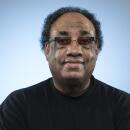The Eyewitness
Forget about that circle with the dot. Gabor Rona is the true eye of CBS. From 195 until his retirement in 1984, Rona, 73, was a staff photographer for CBS and eyewitness to television’s early glory days.
His gallery resembles a “Who’s Who” and “What’s What” of TV history. Rona visited the sets of “The George Burns and Gracie Allen Show,” “The Ed Sullivan Show,” “The Twilight Zone,” “Rawhide” and numerous others--to capture the stars in candid and not-so-candid moments for publicity photos.
“I was there during the golden age of television,” Rona says. “Television wasn’t like it is today. It was very small. Not too many people had sets. Most of the shows were live, like ‘Playhouse 90’ or ‘Studio One.’ It was truly a glorious and wonderful time, and I couldn’t believe I was in the middle of it.”
To look at the hundreds of pictures in Rona’s private collection is to look at the stars and shows with a fresh eye.
There is a fresh-scrubbed, youthful Johnny Carson, posing with an owl and a typewriter for “Carson’s Corner.” (“I was one of the first people to ever photograph him,” Rona says.) There are Ginger Rogers and Fred Astaire, caught smiling in full swing during a rehearsal for a music special.
Rona was there in 1952 at the first birthday of Lucie Desiree Arnaz. He persuaded a young Clint Eastwood to lie in a field of tall grass and smile for a “Rawhide” publicity shot. He shot Errol Flynn on “The Red Skelton Show,” the last time Flynn performed.
Also prominent in the collection are shots of Tallulah Bankhead, Judy Garland, Mickey Rooney, Jack Benny, Humphrey Bogart, Steve McQueen, Mario Lanza, Peter Lorre, Buster Keaton--and Lassie.
“I don’t think throughout the years that there were two people I couldn’t get along with,” Rona says. “I was friends with Lucy and Desi and quite a few others. Still, it was a challenge every time to get everything right. I would have to go on these sets where people were very involved, and sometimes it would take 15 to 20 minutes just to break all the barriers down.”
One of Rona’s favorite subjects was Alfred Hitchcock, who produced “Alfred Hitchcock Presents” for the network from 1955 to 1960.
“Most of the actors and actresses would show up late for sessions, but if Alfred Hitchcock told you he would be there at 10:30 for an hour and a half, the door would open at 10:30 sharp, and he would walk in,” Rona says.
“He knew what kind of shots would help the show. He came up with a corny idea once of putting a crow on his shoulder, but it really worked. Then, in an hour and a half sharp, after all the pictures were taken, he would walk right back out again.”
Less enthusiastic about picture-taking was Bing Crosby. “There were one or two legends who hated to have their pictures taken, and Bing was one of them,” Rona says. “People told me, don’t be surprised if he doesn’t show up. But he did, and we got along so well that he invited me out to his house to do a family portrait.”
Rona says the historical value of his collection is hard to estimate. He doesn’t keep it at his San Fernando Valley home for security reasons. He plans to donate the pictures to a college or museum archives--but not yet.
“I still like looking at them,” he says. “I’m just glad I was around to capture it all.”
More to Read
The complete guide to home viewing
Get Screen Gab for everything about the TV shows and streaming movies everyone’s talking about.
You may occasionally receive promotional content from the Los Angeles Times.





